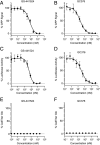Generation of SARS-CoV-2 reporter replicon for high-throughput antiviral screening and testing
- PMID: 33766889
- PMCID: PMC8053989
- DOI: 10.1073/pnas.2025866118
Generation of SARS-CoV-2 reporter replicon for high-throughput antiviral screening and testing
Abstract
Severe acute respiratory syndrome coronavirus 2 (SARS-CoV-2) research and antiviral discovery are hampered by the lack of a cell-based virus replication system that can be readily adopted without biosafety level 3 (BSL-3) restrictions. Here, the construction of a noninfectious SARS-CoV-2 reporter replicon and its application in deciphering viral replication mechanisms and evaluating SARS-CoV-2 inhibitors are presented. The replicon genome is replication competent but does not produce progeny virions. Its replication can be inhibited by RdRp mutations or by known SARS-CoV-2 antiviral compounds. Using this system, a high-throughput antiviral assay has also been developed. Significant differences in potencies of several SARS-CoV-2 inhibitors in different cell lines were observed, which highlight the challenges of discovering antivirals capable of inhibiting viral replication in vivo and the importance of testing compounds in multiple cell culture models. The generation of a SARS-CoV-2 replicon provides a powerful platform to expand the global research effort to combat COVID-19.
Keywords: COVID-19; SARS-CoV-2; antivirals; high-throughput antiviral screening; replicon.
Copyright © 2021 the Author(s). Published by PNAS.
Conflict of interest statement
Competing interest statement: All authors are employees of Merck and Company, Inc. A provisional patent application on the discoveries of this work has been filed.
Figures



Similar articles
-
SARS-CoV-2 replicon for high-throughput antiviral screening.J Gen Virol. 2021 May;102(5):001583. doi: 10.1099/jgv.0.001583. J Gen Virol. 2021. PMID: 33956592 Free PMC article.
-
Construction of a Noninfectious SARS-CoV-2 Replicon for Antiviral-Drug Testing and Gene Function Studies.J Virol. 2021 Aug 25;95(18):e0068721. doi: 10.1128/JVI.00687-21. Epub 2021 Aug 25. J Virol. 2021. PMID: 34191580 Free PMC article.
-
Engineering a Reliable and Convenient SARS-CoV-2 Replicon System for Analysis of Viral RNA Synthesis and Screening of Antiviral Inhibitors.mBio. 2021 Jan 19;12(1):e02754-20. doi: 10.1128/mBio.02754-20. mBio. 2021. PMID: 33468688 Free PMC article.
-
Reporter Replicons for Antiviral Drug Discovery against Positive Single-Stranded RNA Viruses.Viruses. 2020 May 30;12(6):598. doi: 10.3390/v12060598. Viruses. 2020. PMID: 32486283 Free PMC article. Review.
-
Phytochemicals for the treatment of COVID-19.J Microbiol. 2021 Nov;59(11):959-977. doi: 10.1007/s12275-021-1467-z. Epub 2021 Nov 1. J Microbiol. 2021. PMID: 34724178 Free PMC article. Review.
Cited by
-
RNA replication-independent, DNA linearization-dependent expression of reporter genes from a SARS-CoV-2 replicon-encoding DNA in human cells.PLoS One. 2024 Aug 16;19(8):e0300491. doi: 10.1371/journal.pone.0300491. eCollection 2024. PLoS One. 2024. PMID: 39150942 Free PMC article.
-
Marine Natural Products as Leads against SARS-CoV-2 Infection.J Nat Prod. 2022 Mar 25;85(3):657-665. doi: 10.1021/acs.jnatprod.2c00015. Epub 2022 Mar 15. J Nat Prod. 2022. PMID: 35290044 Free PMC article.
-
CRISPR-based engineering of RNA viruses.bioRxiv [Preprint]. 2023 May 20:2023.05.19.541219. doi: 10.1101/2023.05.19.541219. bioRxiv. 2023. Update in: Sci Adv. 2023 Sep 15;9(37):eadj8277. doi: 10.1126/sciadv.adj8277. PMID: 37292641 Free PMC article. Updated. Preprint.
-
Construction and validation of a cell based reporter assay for identifying inhibitors of SARS coronavirus 2 RNA dependent RNA polymerase activity.Sci Rep. 2025 May 26;15(1):18443. doi: 10.1038/s41598-025-03813-y. Sci Rep. 2025. PMID: 40419748 Free PMC article.
-
Nucleoside analog GS-441524: pharmacokinetics in different species, safety, and potential effectiveness against Covid-19.Pharmacol Res Perspect. 2022 Apr;10(2):e00945. doi: 10.1002/prp2.945. Pharmacol Res Perspect. 2022. PMID: 35396928 Free PMC article. Review.
References
MeSH terms
Substances
LinkOut - more resources
Full Text Sources
Other Literature Sources
Medical
Research Materials
Miscellaneous

